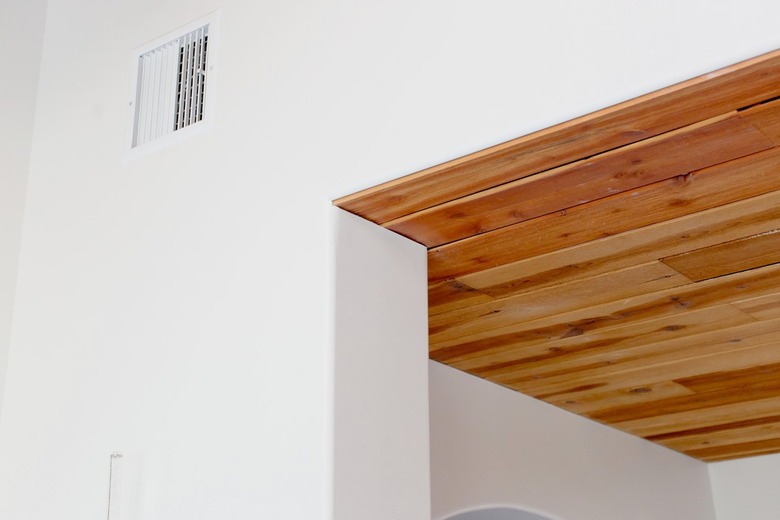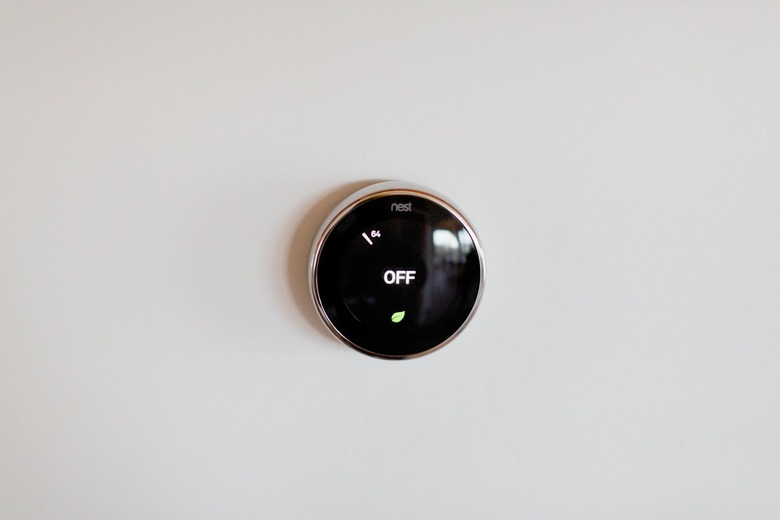The Components Of A Forced-Air HVAC System
We may receive a commission on purchases made from links.
If you have vent registers on the floors and walls of your house, you have a forced-air HVAC system, which means you have a central furnace or air conditioner that heats or cools the whole house. Not all heating and cooling systems are forced-air systems. Baseboard heaters, wall-mounted gas heaters and in-floor pipes that supply radiant heat are all examples of passive heaters that rely on natural convection (instead of a fan) to distribute warm air, and while a window-mounted air conditioner has a blower, it typically services only a single room instead of the whole house.
It goes without saying that a forced-air HVAC system has to have a blower because that's what does the forcing, but it must have a number of other components as well. At a minimum, it needs a furnace, air conditioner or heat pump to condition the air, a ductwork system to exchange air in the house with conditioned air, a flue to exhaust combustion gases (for oil and gas-powered systems) and a thermostat to control it. If the system includes an air conditioner or a heat pump, it also has to have a condensing unit, and this is usually situated outside and connected to the indoor unit by tubing that carries the electrical wires and refrigerant lines.
The Furnace Is the Heart of a Heating System
The Furnace Is the Heart of a Heating System
Although central air conditioning is becoming more common, most central HVAC systems are heating systems that employ a furnace that supplies heat in one of two ways. Gas furnaces burn a fuel, and electric furnaces have resistive heating elements that work much like the elements on a typical electric stove top or in an electric dryer. The initial cost of an electric furnace is usually less than that for a gas furnace, but this financial advantage is quickly lost because electricity is more expensive as a heat source than other fuels. However, electric furnaces need less infrastructure than gas ones and are generally cleaner and easier to maintain, and in places that lack municipal gas services, they might be the only option.
An HVAC system that services a gas furnace must include a flue to vent combustion gases out of the building. The flue is a galvanized steel pipe that typically rises through the roof and terminates with a capped pipe, much like a chimney. Combustion produces toxic gases, such as carbon monoxide, so it's vitally important that the combustion chamber of a gas furnace be sealed and airtight, and that's another drawback of gas furnaces. The heat gradually weakens the metal of the combustion chamber enclosure and shortens the life of the furnace to between 15 and 20 years, whereas an electric furnace can last from 20 to 30 years.
Some Heating Systems Use a Heat Pump
Some Heating Systems Use a Heat Pump
A heat pump works much like an air conditioning system but in reverse, and one of its advantages is that it can switch functions between heating and cooling. It consists of two sets of coils, a refrigerant and a compressor. The evaporator coils are typically housed inside the building, while the compressor and condenser coils are outside. In the evaporator coils, the refrigerant evaporates and draws heat from the air, and in the condenser coil, the refrigerant gas liquefies -(condenses) and releases the heat to the outdoor air. By switching the direction of refrigerant, using the refrigerant the house can receive either the cool air from the evaporator coil or the warm air from the condenser coil.
It's All Inside an Enclosure
It's All Inside an Enclosure
The unimpressive metal box from which all the ductwork in many HVAC systems emanates is either the furnace or the air handler, and it houses the blower and filters to clean the circulated air. If the system includes an air conditioning unit or heat pump, the evaporator coil is inside the air handler. Many furnaces and air handlers, known to HVAC pros as air handling units, also house sound attenuators to reduce noise and vibrations from the mechanical units inside.
The blower is typically a drum with fins that spins on a horizontal axis. It's located at the bottom of the furnace compartment or air handler, and as it spins, it forces air past the heat exchanger or evaporator coil into the main duct outlet, which splits into smaller branches to feed individual rooms. The blower gets air from a return duct that comes from the furnace room or from another room in the house, and inside the return duct is a removable filter that removes dust and pollen from the air but the filter's primary function is to protect the internal components. The blower motor is electric even if the furnace burns gas, and a signal from the thermostat tells it when to cycle on and off.
The most common filters are flat-panel filters consisting of fiberglass fibers stretched over a cardboard frame, but while these inexpensive filters are fine for air coming into the air handler, they aren't the most efficient ones for the outgoing air that people breathe. Pleated filters made with cotton or plastic fibers are better, and the best are electrostatically charged to better attract dust particles. Efficient filters limit airflow, however, and not all systems are designed for them, so it's best to check with a pro before retrofitting your filters.
The Heat Exchanger and Evaporator Coil
The Heat Exchanger and Evaporator Coil
Inside a furnace is a heat exchanger, which is an enclosure, typically metal, that transfers the heat from the burner or heating element to the surrounding air. The heat exchanger is hermetically sealed and includes the flue that exhausts combustion gases from a gas furnace, and in high-efficiency units, the combustion gas passes through the flue to a secondary heat exchanger where moisture in the gas mixture condenses into a liquid, releasing even more heat.
High-efficiency furnaces are those that are more than 90 percent efficient, meaning they convert 90 percent or more of the fuel they use (98.5 percent is the highest) into usable heat. These furnaces have a secondary heat exchanger and are sometimes known as condensing furnaces. Proximity to the heat source stresses the metal from which the primary heat exchanger is made, and when tiny cracks and holes that release the toxic gases into the furnace room develop, it's usually time for a furnace upgrade.
In the air handler for an air conditioning system or heat pump, the heat exchanger is replaced by an evaporator coil. It's typically located in the plenum at the top of the air handler where the outflow duct attaches, which ensures that all the cool air it produces is circulated through the duct. Sometimes, a furnace and air conditioning system share the same enclosure, in which case the coil is positioned just above the heat exchanger. The coil needs periodic cleaning, so the air handler has a removable panel that allows access to it. You can clean the coil with compressed air or by brushing and wiping it with soap and water, and you can help keep it clean by regularly cleaning or replacing the intake filter.
Ductwork Distributes the Air
Ductwork Distributes the Air
Ductwork is an often underappreciated feature of a home's HVAC system, and it's vitally important. It must be designed in such a way to minimize turbulence and optimize airflow so that heated air travels uniformly through each air terminal — the technical name for each of the floor and wall vents in the home. Most ducts are made from galvanized steel, but some are made from lightweight aluminum, fiberglass and even foil-coated polyurethane foam for insulation.
In its simplest form, a ductwork system is a continuous network that extends from the furnace or air handler and branches out to feed every thermal zone in the house, but most systems incorporate a number of features to control and optimize airflow:
- Volume control dampers regulate airflow to each of the terminals. If one room in the house is getting hot while another room stays cold, one or more of these dampers may need to be adjusted. If the duct passes through a fire curtain or firewall, it should also have smoke and fire dampers that allow the duct to be sealed off completely.
- Vibration isolators inserted near the air handler prevent noise and vibrations created by the blower motor from being transferred through the ducts.
- Stack boots and heads provide transitions from the main duct to smaller oval or rectangular ducts that travel vertically behind walls.
- Turning vanes are elbow fittings that contain a network of vanes that help reduce turbulence in the air as it changes directions.
- "Terminal units" is the technical term for vent covers. Some are fitted with small fans and heating coils to boost the air temperature without having to run the entire system at a higher setting.
Ductwork joints are typically sealed with aluminum foil tape (not duct tape, as you might expect) to keep them airtight because small leaks reduce the efficiency of the entire heating and cooling system and drive up energy costs. Metal air ducts are often covered with fiberglass or foam insulation to prevent heated air from condensing as it contacts the cold metal. Moisture is a mold magnet, so homeowners are advised to have uninsulated ducts inspected every few years and cleaned if necessary.
The Thermostat Is the Control Center
The Thermostat Is the Control Center
If the furnace, air conditioner or heat pump is the heart of an HVAC system, the thermostat is the brain. It contains a temperature-sensitive device that senses the room temperature and sends a signal to the heating or cooling system to switch on when the temperature falls below or rises above a preset value. The sensing device in older mechanical thermostats, which are still in use in some homes, is a bimetallic strip or coil, but modern electronic thermostats employ a thermistor, which is an electronic component with an electrical resistance that changes with the temperature.
Thermistors are far more sensitive than other sensors and make it possible to maintain room temperature within a narrow range, although most thermostats allow some leeway to avoid having the system switch on and off too often. If a contemporary thermostat isn't performing as expected, it's often for some reason other than the thermostat itself, and the most common reason is poor placement. A thermostat near an open window, over a vent or in a place that gets full sun won't sense the temperature accurately. If you notice that the temperature in your house is always too hot, it could be because the thermostat is too close to an open window and thinks it's colder in the house than it actually is.
Besides being more sensitive, contemporary thermostats are also programmable so that you can shut off the HVAC system when you aren't home and have it come on just before you come back, which saves energy. If you have a heat pump, you can use the thermostat to switch between heating and cooling functions, and if you've divided your house into heating zones using dampers in the ductwork, you can purchase a thermostat that will control each zone separately. The most sophisticated modern thermostats are Wi-Fi enabled, allowing you to change the program settings remotely using a mobile device.
References
- A-1 Mechanical: How Long Does a Furnace Last?
- Standard Heating & Air Conditioning: Ask the Expert: What is a Heat Exchanger?
- Entek Corporation: Which is Best? Electric Furnace or Gas Furnace
- HVAC Training 101: HVAC Ductwork 101: All You Need to Know
- InspectAPedia: Thermistors
- HomeTips: How Forced-Air Systems Work
- Standard Heating & Air Conditioning: HVAC Diagram
- Home Tips: Buying a High-Efficiency Furnace

